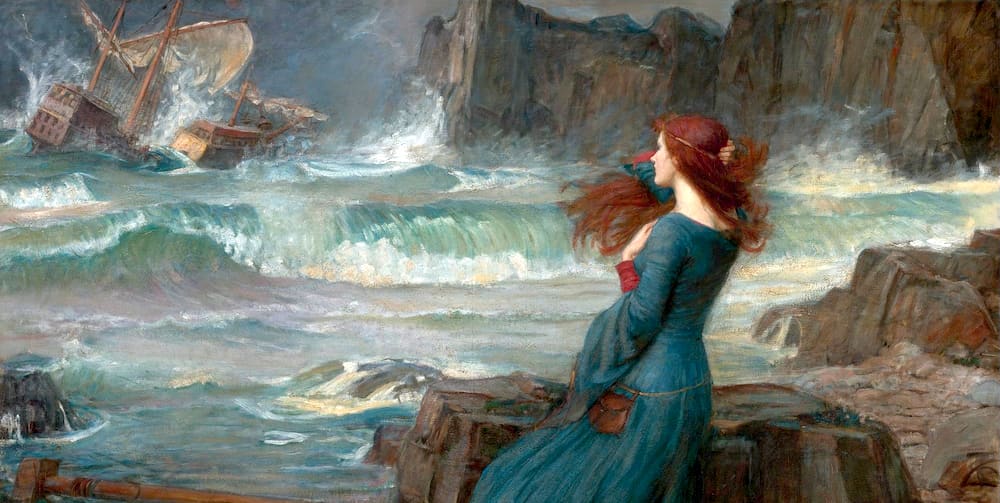“The Tempest” by William Shakespeare is a timeless play that continues to captivate readers and audiences around the world. First performed in 1611, this tragicomedy takes us on a journey filled with enchantment, treachery, and ultimately, forgiveness. In this book review, we will explore the key themes, characters, and literary elements that make “The Tempest” a masterpiece of dramatic literature.
Table of contents
Introduction
In the vast repertoire of William Shakespeare, “The Tempest” stands out as a unique and thought-provoking play. With its rich tapestry of characters, intricate plot, and exploration of complex themes, this work showcases Shakespeare’s mastery as a playwright. “The Tempest” invites readers to delve into a world where magic and reality interweave, where illusions and truths collide, and where redemption and forgiveness triumph over vengeance.
Synopsis
“The Tempest” takes place on a remote island, where Prospero, the rightful Duke of Milan, has been exiled with his young daughter, Miranda. Using his powers of sorcery, Prospero conjures a The Tempest that brings a ship carrying his treacherous brother Antonio and his allies to the island. The play unfolds as Prospero seeks justice, exposes the true nature of his enemies, and orchestrates their transformation through a series of trials.
Themes and Symbolism
Magic and Power
“The Tempest” explores the theme of magic and power, as embodied by Prospero. The island serves as a metaphorical realm where Prospero’s magical abilities grant him control over the lives of those who trespass upon it. The play examines the moral implications of such power and questions whether it is right to manipulate others through sorcery. Through Prospero’s journey, Shakespeare prompts us to reflect on the nature of authority and the responsibility that comes with it.
Betrayal and Forgiveness
Betrayal is a central theme in “The Tempest.” Prospero’s brother, Antonio, seizes his dukedom, usurping his position and casting him and Miranda adrift at sea. The play delves into the consequences of betrayal and the complex emotions associated with it. However, “The Tempest” also presents a powerful exploration of forgiveness and redemption. Prospero’s ultimate choice to forgive his enemies highlights the transformative power of compassion and challenges the notion of revenge.

Colonialism and Freedom
Another theme that resonates throughout “The Tempest” is colonialism and freedom. The presence of characters like Caliban, an indigenous inhabitant of the island, raises questions about the ethics of colonization and the treatment of native populations. Shakespeare subtly critiques the actions of European explorers and emphasizes the importance of respect and empathy towards other cultures. “The Tempest” serves as a commentary on the exploitative nature of colonial enterprises and advocates for freedom and equality.
Character Analysis
Prospero
Prospero is the central character of “The Tempest” and embodies a complex mix of power, wisdom, and vulnerability. He is a sorcerer who uses his magical abilities to orchestrate events on the island. Prospero’s thirst for revenge initially drives his actions, but as the play progresses, we witness his transformation from a vengeful figure to a benevolent ruler. His growth stems from his realization that forgiveness and reconciliation are more powerful than vengeance. Prospero’s character serves as a reflection of Shakespeare’s exploration of the human capacity for both cruelty and compassion.
Miranda
Miranda, Prospero’s daughter, represents purity, innocence, and love. She has spent her life isolated on the island, unaware of the world beyond its shores. Miranda’s encounters with the shipwrecked men awaken her curiosity and compassion. Her presence in the play offers a contrasting perspective to the other characters, as her upbringing has shielded her from the darker aspects of human nature. Miranda’s character symbolizes the potential for growth, empathy, and the transformative power of love.
Caliban
Caliban is an intriguing and complex character in “The Tempest.” He is portrayed as a deformed and savage creature, a native of the island who is enslaved by Prospero. Caliban’s character represents the marginalized and oppressed in society. Shakespeare raises questions about the treatment of indigenous people and challenges the notion of superiority and entitlement held by the colonizers. Despite his initial portrayal as a villain, Caliban’s character also elicits sympathy as we witness his desire for freedom and his yearning for a life beyond servitude.
Ariel
Ariel, the spirit and servant of Prospero, embodies ethereal beauty and enchantment. Ariel’s character exemplifies the conflict between loyalty and personal freedom. Although bound to Prospero’s service, Ariel longs to be liberated. This tension adds depth to the play, as Ariel’s desire for freedom parallels the struggle for freedom experienced by other characters. Ariel’s character showcases the transformative power of liberation and reminds us of the importance of individual agency and self-discovery.
Literary Techniques
Use of Language

Shakespeare’s language in “The Tempest” is a testament to his poetic genius. He skillfully weaves together verse and prose to convey the emotional depth of the characters and the complexities of the themes. The play is replete with beautiful metaphors, captivating imagery, and rhythmic dialogues that elevate the storytelling. Shakespeare’s use of language not only serves to entertain but also invites deeper exploration of the human experience.
Structure and Imagery
The structure of “The Tempest” follows a five-act format, which is typical of Shakespearean plays. The strategic placement of scenes and acts creates a sense of pacing and suspense, heightening the dramatic impact. Additionally, the vivid and evocative imagery employed throughout the play transports the audience to the enchanting island setting. The storm, the ethereal spirits, and the natural elements serve as powerful symbols that enhance the thematic depth and engage the readers’ senses.
Metaphors and Allusions
“The Tempest” is renowned for its masterful use of metaphors and allusions. Shakespeare employs these literary devices to convey complex ideas, create layers of meaning, and draw connections to broader cultural and philosophical concepts. For instance, Prospero’s magic and The Tempest itself can be seen as metaphors for the turmoil within human nature and the transformative power of self-reflection. The play’s allusions to classical mythology and biblical references further enrich the narrative, offering a deeper exploration of the human condition.
Critical Reception and Legacy
“The Tempest” has garnered both critical acclaim and lasting popularity since its inception. While the play was not as commercially successful during Shakespeare’s time compared to some of his other works, it has become widely recognized as a profound and thought-provoking masterpiece. Critics have praised the play’s exploration of themes, its intricate characterization, and its poetic language.
The ambiguity and complexity of “The Tempest” have contributed to its enduring appeal. The play’s examination of power dynamics, colonialism, betrayal, and redemption continues to resonate with audiences across different time periods and cultural contexts.
In recent years, “The Tempest” has also been subject to various adaptations and reinterpretations, highlighting its relevance in contemporary society. Directors, playwrights, and scholars have explored themes of race, gender, and postcolonialism within the play, offering fresh perspectives and engaging with ongoing social and political discussions. The versatility of “The Tempest” allows for a multitude of interpretations, ensuring its continued relevance and relevance in the ever-evolving world of theater and literature.
Cultural Impact
“The Tempest” holds significant cultural value and has made a lasting impact on various aspects of the arts and popular culture. Its themes, characters, and iconic lines have permeated literature, theater, music, film, and other art forms. Here are a few examples of its cultural influence:
Literature: “The Tempest” has served as a source of inspiration for numerous writers and playwrights. Its themes of power, betrayal, and forgiveness continue to resonate in contemporary literature. Many authors have drawn upon Shakespeare’s work, adapting and reimagining its elements in their own stories, thus keeping its legacy alive.
Theater and Performance: “The Tempest” remains a staple in theater productions worldwide. Its compelling characters, dramatic plot, and poetic language offer actors and directors a rich canvas for interpretation. Countless performances have breathed new life into the play, exploring different themes, settings, and character dynamics, allowing audiences to engage with its timeless themes in fresh and innovative ways.
Film and Television: “The Tempest” has been adapted for the screen numerous times, demonstrating its enduring appeal beyond the stage. Notable film adaptations include Derek Jarman’s 1979 film “The Tempest” and Julie Taymor’s 2010 film “The Tempest,” which featured a gender-swapped portrayal of Prospero as Prospera, played by Helen Mirren. These adaptations showcase the versatility of the play and its ability to resonate with contemporary audiences through visual storytelling.
Music and Opera: The themes and characters of “The Tempest” have also found their way into the world of music. Composers such as Henry Purcell, Thomas Adès, and Jean Sibelius have created musical works inspired by the play. In addition, the play’s influence can be seen in popular songs, with lyrics and references drawing from its iconic lines and themes.
Visual Arts: “The Tempest” has served as a muse for visual artists, with its rich imagery and symbolism inspiring paintings, illustrations, and other forms of visual expression. Artists have explored the play’s themes and characters, capturing the magic, turmoil, and transformative elements depicted within its pages.
Academic and Cultural Discourse: “The Tempest” has been the subject of extensive scholarly analysis and critical discourse. It has sparked discussions on topics such as postcolonialism, gender, and race, leading to a deeper understanding of its social and cultural implications. The play’s exploration of power dynamics and colonialism has contributed to broader conversations on these topics, both within academia and in wider society.
In conclusion, “The Tempest” has left an indelible mark on culture, influencing literature, theater, film, music, visual arts, and academic discourse. Its enduring themes, complex characters, and poetic language continue to inspire and engage audiences across generations, ensuring that its cultural impact remains profound and far-reaching.
Conclusion
“The Tempest” by William Shakespeare is a masterpiece that delves into the complexities of human nature, power, forgiveness, and redemption. Through its exploration of magic, betrayal, and colonialism, the play raises profound questions about authority, empathy, and the transformative power of compassion. The characters of Prospero, Miranda, Caliban, and Ariel embody a range of human experiences, showcasing Shakespeare’s ability to create multidimensional and relatable figures.
Shakespeare’s use of language, structure, and literary techniques further elevates the play, immersing readers in a world of enchantment and introspection. The enduring legacy of “The Tempest” is evident in its critical reception, its ongoing relevance in contemporary adaptations, and its ability to provoke meaningful discussions on a wide range of social and philosophical issues.
In conclusion, “The Tempest” stands as a testament to Shakespeare’s brilliance as a playwright and his profound understanding of the human condition. It is a work that continues to captivate and inspire, reminding us of the enduring power of forgiveness, the complexities of power, and the potential for transformation and redemption.



 For all latest articles, follow on Google News
For all latest articles, follow on Google News